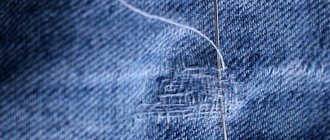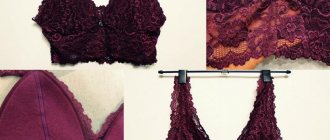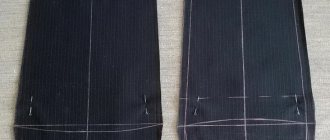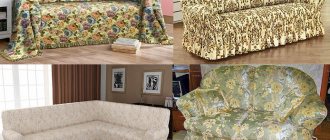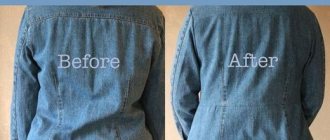Greetings to everyone who cares about more than just design in technology! When purchasing an expensive or budget sewing machine, we expect (or hope) that we will be able to work on it without problems. However, this illusion quickly passes, but is it always worth running to a service center or can you solve the problem yourself? In this article, we will analyze the most common malfunctions of sewing machines and their elimination without the services of a specialist. I will not dwell on such malfunctions as slow sewing speed, increased noise, creasing and tearing of fabric, regular needle breakdown, since malfunctions of this kind are often associated with wear and tear of parts and require professional service.
Main malfunctions of sewing machines
Most often at home you may encounter the following types of problems:
- an unstable stitch is observed, gaps form in the stitching, stitches may be different in length, thread breaks occur in places;
- the progress of the stitching is disrupted, the fabric is pulled together into an accordion, there is either a weakening or strong tightening of the loop, a bevel of the stitching;
- the speed changes, the machine makes an uncharacteristic noise, and it jams.
Stitch instability
If any of the listed problems are observed, this indicates that it is necessary to pay attention to the operation of the machine to determine the cause.
Note! If you carry out timely adjustments and settings, you can solve the problem without much effort and large financial investments. If your sewing machine does not function properly for a long period of time, it may result in the need for costly repairs.
Self-Configuration Guidelines
You can set up the device yourself if you follow a certain plan:
- First of all, you need to adjust the springs that lift the threads. They must be twisted in such a way that the wound loop does not unwind, but is held by the bobbin cap.
- It is important to achieve the correct thread tension. For this purpose, the machine has a special mechanism located on the side of the body and in the interlinear screw of the shuttle. To tighten the bobbin thread, you need to tighten the locator screw.
- After setting the thread, you need to check the work on a piece of material. If hanging loops form, the top thread needs to be loosened.
Checking the thread setting
- Next you need to set the presser foot pressure. This is done by adjusting the springs with a special bolt. In most modern models it is located in an accessible place so that it can always be easily adjusted during operation. It is important that the spring is not too overtightened, but not too loose. If the presser foot presses the fabric too tightly against the body surface, it will increase the pressure and may cause the fabric to rip. If the foot, on the contrary, does not clamp the material sufficiently, the seam will turn out sloppy. The presser foot needs to be adjusted every time a new type of material is used. The thicker the fabric, the greater the presser foot pressure.
- Check the operation of the electric drive. Often malfunctions in the functioning of sewing machines occur due to the fact that the speed is incorrectly set. They are set by a special regulator located in the pedal. If the sewing speed is broken, you need to disassemble the pedals, clean them and put them back. If this procedure does not help, you need to replace the contacts in the pedal.
- Check the condition of the needle holder. The needle should be firmly installed all the way, the large groove should be turned to the left.
Before work, you must also set the stitch length. This is the exact value that is set for each type of fabric in accordance with the instructions. The average value is from 1 to 2 mm; if the material is thick, then the parameter can reach 3 mm.
Checking the sewing machine before use
Possible reasons for the top thread breaking
— After disassembly, the upper thread tensioner is incorrectly assembled. — Incorrect threading. — Poor quality threads. — The thread number does not match the needle number. — The spring of the bobbin case lock has weakened. Inside the bobbin case you can find a very small screw, and if you unscrew it, the lock mechanism can be removed and you will find a long spring. Try to stretch this spring slightly, but it is better to buy a new bobbin case. — There are nicks and burrs along the path of the thread to the needle. Carefully follow the path of the thread and, after detecting nicks, remove them with a small needle file. In older Podolsk-type machines, there may be thread cuts on the tensioner rod. Disassemble the tensioner and inspect the rod; if there are such cuts, remove them with sandpaper.
Troubleshooting and troubleshooting yourself
The user of the machine can identify and fix a certain number of problems on his own if he understands the principle of operation of the machine.
Attaching the needle bar and tensioner
The most important element in the operation of a sewing machine is the needle. Before you start setting up, you need to check its functioning. During operation, a large load is placed on the needle. She makes a huge number of punctures in the fabric. This results in dulling and bending over time. It is very dangerous for the needle to hit the metal body. This will cause the tip to break immediately. Craftsmen with little experience may not immediately notice the defect. And working with such a needle creates large tears in the fabric.
A thread that is threaded through a broken eyelet will constantly snag, which can lead to deformation of the fabric. Loops may appear in the stitching. Because the needle is bent, the thread may continually break. This makes it difficult to stitch difficult areas where the top thread needs to be kept as tight as possible.
Checking the condition of the needle holder
For your information! In this case, adjustment and repair of the sewing machine is not required. You can fix the problem if you replace the needle yourself. Experts recommend changing this element as often as possible to make the machine work better.
When changing the needle, you must adhere to the following rules:
- The sewing needle should be selected only in exact accordance with the type of equipment. You cannot insert a needle for an industrial device into a household machine. In such a situation, the gap between the nose of the shuttle and the needle blade will be compromised. This will cause skipped stitches. In the worst case, the shuttle may break.
- It is important to position the element correctly in the needle holder. The blade should be on the side of the shuttle nose.
- Before replacing, even a new needle needs to be checked. There should be no distortions on it. This may not be noticed immediately. It is recommended to place the needle on the glass. The location of the curvature will immediately become noticeable.
- The needle should be selected according to the fabric being used. For jeans, stretch or faux leather, you need to choose special needles that allow easier passage through the fabric.
The needle must match not only the fabric and machine model, but also the thread number.
It is important to pay attention ! New sewing machines have a certain feature: they have a guide stop that prevents the point from moving to the side.
Setting the interaction between the hook tip and the needle
The quality of the row and stitch depends on the proper settings of the shuttle assembly and the sewing machine needle. The correct values must be set between them. If they are broken, thread breaks, looping, and omissions may occur. To perform the setup correctly, you need to understand the principle of loop formation.
As soon as the needle rises 2 mm, a loop is formed from the upper thread. At this time, the nose of the shuttle should pass close to the hollow of the needle. It is important that this distance is no more than 0.15 mm. And the distance from the eye of the needle and the nose should be 0.5 mm. These parameters apply to working with fabrics of medium thickness.
For your information! It is important to pay attention to the correct installation of the rack. It should be positioned vertically. It is the rail that moves the fabric relative to the needle. As soon as the material is pierced with a needle, the edges of the teeth of the rack should be at the level of the sewing machine work table.
People often ask, “which car is better?” This article answers:
In the photo there is 1 sewing machine of class 1022. There is no probe on the surface of the platform.
For machines 1022, the needle bar diameter is 6.5 mm.
Photo 1.
In photo 2, sewing machine 1022 M class. It has a dipstick on the surface of the platform to check the oil level in the crankcase located under the platform. Shown with a red circle.
The needle bar diameter of this machine is 1022 M - 8 mm.
Photo 2.
Both machines sew the same thickness of material. But for a 1022 machine, 3 layers of faux fur and a layer of non-woven fabric, on a 120 needle, the maximum load. Then for a 1022 M machine, the permissible thickness is due to the thickness of the needle bar.
In photo 3, the front part of any sewing machine. It consists of a needle bar device:
- Front housing.
- Lower needle bar bushing.
- Needle bar clamp.
- Needle bar.
- Upper bushing, needle bar.
Photo 3.
If a seamstress pulls the material with her hands, she pulls because there is a thick layer under the foot. Then the load happens immediately:
Here's what happens to the mechanism:
- A lateral load appears on the lower needle bar bushing. On the 1022 machine, the needle bar bends slightly, which causes wear on the lower part of the bushing. Since the needle bar is steel, hardened, the sleeve for sliding is steel but not hardened.
- The gap changes, the flat of the needle - the nose of the shuttle. from 0.1 mm 0 mm, that is, the nose, scrapes the flat of the needle. After 5-6 hours of work, such an influx of metal forms on the nose of the shuttle, Figure 4. The machine begins to make gaps.
- The hook nose needs sharpening. How many times can the hook nose be sharpened? The answer to this question is Figure 4.
Figure 4.
—
Figure 5 shows the main parts in the shuttle.
- Shuttle nose.
- Needle.
- Bobbin protrusion.
As soon as the plane of the shuttle nose wears out more than 2/3 of the hole in the bobbin case, the shuttle must be thrown away. See photo 5.
Photo 5.
In photo 6, you can see that between the needle and the edge of the bobbin case, the gap is less than 0.1 mm. This suggests that the shuttle is on the verge of replacement. And with a different position of the needle, the capture of the loop by the nose of the shuttle no longer occurs. A needle No. 120 is installed. The diameter of the needle is 1.2 mm. Half diameter is 0.6 mm + 0.1 mm = 0.7 mm. So, from the photo, you can calculate the approximate gap, the tip of the nose, relative to the edge of the bobbin. You can extend the life of the shuttle for some time. If you sacrifice the bobbin case. Grinding off the edge of the bobbin case with a diamond file, at the entrance of the needle. You can sharpen until the file touches the bobbin, approximately 0.5 mm. But at the same time, you need to understand that the chance of breaking a needle on a bobbin when sewing increases.
Photo 6.
Needle bar wear, lower bushing wear, needle bar wear and hook wear. Here are the consequences of sewing thick fabric on machine 1022.
Observing the work of seamstresses in a private workshop, the operation of machines, I noticed the following trend:
- The machines are not lubricated by seamstresses after finishing work.
- Those seamstresses who work on 1022 M machines believe that they have centralized lubrication, and that is enough.
- Seamstresses who sew on class 1022 machines believe that since the owner hired a mechanic, that means it’s his job.
- A seamstress, as a rule, is taught by a mechanic how to position the needle correctly in relation to the nose of the shuttle. But as soon as gaps appear, and on 1022 machines this is usually when sewing a thick layer, after 10-12 hours of work, the seamstress begins to twist the needle. Thus, dulling the nose of the shuttle even more.
- The mechanic who came in the morning disassembles, grinds off some of the metal from the shuttle, sets out the shuttle and the needle.
- When working on the owner's sewing machine, the mechanic changes the shuttle, needle bar, and lower shuttle bushing every three months. That is, enough for one season.
- If a seamstress sews at home and pays for setting up from her own pocket, then for such a machine of class 1022, the mechanic changes the shuttle, needle bar, and lower shuttle bushing every 7-8 months. Taking care of your car and taking the mechanic’s words completely differently.
- On 1022 machines, when the lower needle bar bushing wears out, the needles break more often. Broken needles injure the thread guide plate of the shuttle. Leaving your marks on it. See photo 5. These marks cause the upper thread to break. The mechanic also cuts them down. It comes to the point that the nose of the shuttle has not yet worn out, but the thread guide plate is already worn out.
In photo 7, wear, thread guide plate, shuttle, “dovetail.”
Photo 7.
I hope everyone understands the difference between the 1022 and 1022 M cars!
Where to get it repaired: average prices in workshops
When choosing a workshop where sewing machines are repaired, it is better to focus on service centers that service the purchased model. In such centers, most often all components are in stock, the client does not have to order them and wait a long time for the work to be completed.
The cost of repair depends on the model and complexity of the breakdown. On average, for a machine of the Veritas, Singer and Janome brands you will have to pay from 800 rubles to 1,500 rubles for a simple breakdown. Repair services for Brother and Jaguar models start at 1,200 rubles.
If we are talking about an industrial sewing machine, its repair can cost 2,000 or more. Repairing older sewing machines can be difficult due to the lack of spare parts. This may increase the waiting time.
Choosing a repair service
The main reasons for writing off furniture (tables, chairs, etc.)
Inventory accounting Expand the list of categories Subscribe to a special free weekly newsletter to keep abreast of all changes in accounting: Join us on social media.
networks: VAT, insurance premiums, simplified tax system 6%, simplified tax system 15%, UTII, personal income tax, penalties We send letters with the main discussions of the week >> Tax-tax January 07, 2021 The reason for writing off a chair, table, cabinet or office chair is the loss of most of the operational characteristics and criteria allowing the further use of the written-off item.
We recommend reading: Should developers provide project documentation?
Let's consider the question in more detail. When we talk about furniture, we mostly think about office furniture.
Although this could also be the setting of retail or industrial premises, as well as catering premises. General points for which furniture can be considered unsuitable for further use are:
> > > Recycling of typewriters Typewriters can now only be seen in a movie theater or a museum of ancient technology. These are devices that were widely used for printing characters on paper and other media in the 19th and 20th centuries.
Gradually they were completely replaced by personal computers equipped with printers. Interestingly, in 2012, Brother released a writing machine that it called “the last one made in the UK.” The device was transferred to the Science Museum in London.
However, in Russia old typewriters can still be found among old things. Rarely are they valuable and can be useful to owners. Most often, this is garbage that you want to get rid of as quickly as possible. What to do in such cases? any release date must be carried out in accordance with all the rules.
If you simply throw the typewriter into a landfill in an unspecified place, then there is a high risk of receiving a fine. In rare cases, when a legal entity needs to recycle this equipment, specialists must write it off.
Proper care of your sewing machine
To ensure that the sewing machine always works properly and does not require constant adjustment, it is recommended to follow preventive measures. The main ones include:
- lubricating the main parts at least once every six months with special oil;
- after each use of the sewing machine, you need to clean the surface and needle plates from dirt and dust that accumulates during operation;
- The sewing machine should only be stored in its case;
- all cords and wires must be carefully twisted to avoid breaking;
- Before putting the machine in its case, you need to check if there are any threads on the elements.
DIY sewing machine repair
Sewing machines do not lose their popularity even in the twenty-first century. Those who were born during Soviet times remember that girls from childhood were taught to sew various things, from gloves to jackets and coats.
During the Soviet era, most people repaired sewing machines themselves. Even today, those who attend cutting and sewing courses understand that it is better to repair a sewing machine yourself than to take it to a service center:
- Firstly, companies that repair sewing machines require quite a lot of money from their clients for the services they provide.
- Secondly, the structure of even modern machines can be understood in a matter of hours; you just need to approach this issue carefully, and in the future this will make it possible to repair sewing machines without involving third parties.
See also -
How does a sewing machine work?
Basic rules for operating a sewing machine
Let's look at the basic rules for operating sewing machines:
- Sewing equipment should not be located near radiators or heaters. But at the same time, it must be in a dry room, in which there are no signs of dampness;
- Before starting work, it is necessary to select the necessary materials and tools, needles and threads that will be needed during the work process;
- Before you start sewing, you need to make sure that the needle and thread guide are in the up position;
- Remember that the sewing machine needs to be assisted while sewing, pulling the fabric towards itself;
- After the sewing work is completed, you need to raise the presser foot and stretch the fabric. Next, cut the thread, having previously found a free end, the length of which will be a maximum of seven, but a minimum of five centimeters.
Solving problems
Below are quick troubleshooting instructions. However, if you have followed the sewing techniques in this book, you will rarely need to use the tips below.
Sewing machine
The machine does not sew . Check the network connection and wires. Check if the machine has a safety system: it will prevent the machine from sewing if any of the covers on the body are not closed properly. Also make sure that the bobbin winder is not in the winding position.
The machine is noisy . Clean and lubricate the machine. If the noise appears suddenly, take the car in for diagnostics.
A thread
The thread breaks
- Check that the upper thread unwinds smoothly and evenly and that it does not catch. Install a spool stopper and, if necessary, put a net on the spool so that the thread unwinds correctly.
- If the upper thread tension is too tight, the thread may break.
- Check the quality of the thread: if it is too fluffy, it will probably clog the eye of the needle and break.
The thread forms knots above the eye of the needle. Either the needle is too small for these threads, or the threads are of poor quality. Change the needle or thread.
Needle
The needle breaks
- Is the needle inserted well into the needle holder? Is the clamp screw tightened enough? Place the needle in the holder correctly, that is, as high as possible, and tighten the clamping screw to the end.
- The needle is too thin for this fabric: take a needle a size thicker.
- Is the presser foot not suitable for the selected stitch and the needle is caught in the presser foot? Change the presser foot or stitch.
The needle bends when sewing
- Is the bobbin you are using suitable for your machine? If necessary, replace it with a bobbin compatible with your machine model. Not all bobbins are the same size.
- The upper thread tension is too tight or the thread is not threaded properly: the thread pulls the needle by the eye and bends it. Rethread the upper thread and reduce the tension.
- The needle is too thin for this fabric: use a thicker needle.
Stitches
The stitches are uneven
If there are layers of fabric with different thicknesses in the path of the presser foot, help it with a compensation plate. If you are using a fancy stitch, check your machine's manual to see if the presser foot you choose will fit.
Stitches are too loose
Reduce the stitch length and, if necessary, the upper thread tension.
Stitches skip (photo 1)
Photo 1
Most often the reason is the needle:
- Either the type of needle is not suitable for the task (for example, you are using a knitting needle on poplin);
- Either the needle is worn out and its point has become dull: the needle does not catch the lower thread and the stitch slips forward;
- Finally, the reason may be that the upper thread is poorly threaded or is not suitable for this needle: match the needles to the threads you are using.
The stitch loops strongly from the wrong side (photo 2)
Photo 2
Rethread the bobbin and bobbin thread, and then rethread the upper thread. If nothing changes, replace the needle with a new one of the same type or with a different type of needle that is more suitable for the fabric. Finally, clean the area under the needle plate.
Problems with sewing machines
There are rules and they must be followed. The use of high-quality materials and additional tools minimizes the occurrence of problems and malfunctions when working with sewing machines. Therefore, the following reasons that lead to malfunctions are the most common:
- Thread break. Breakage can occur in both the upper and lower threads. In the first case, the problem is related to the selection of low-quality threads or the wrong needle size. In the second case, the problem of a sewing machine malfunction may be associated with unevenness, the presence of burrs in the bobbins, and incorrect winding of the thread.
- Problems with fabric advancement. If such a problem occurs, you need to carefully look at the position of the teeth. If they are raised or lowered, then it is necessary to bring them to normal condition;
- Cutting fabric. If such a problem occurs, in order to fix the machine we need to reduce the pressure of the presser foot and check the condition of the needle, perhaps it is too dull.
Broken upper thread
The next most frequently asked question is “Why does the top thread break in a sewing machine?” The reasons are divided into two groups: those related to the selection of accessories and threads and those related to settings and adjustments. First of all, we analyze the reasons of the first group: we check the quality and expiration date of the threads, check whether the thread number corresponds to the number of the installed needle, change the needle for a new one if there are roughnesses and burrs on it.
If the measures described above do not produce results, then you will have to dig deeper. First, you should check whether the thread is threaded correctly. Even if you have sufficient experience in handling a sewing machine, you cannot be completely sure of the correctness of your actions - perhaps you were distracted and did something wrong.
If the machine tears a high-quality and correctly threaded top thread, then the problem may lie in the bobbin case, namely in the spring of its lock. If it becomes loose, it is recommended to purchase a new bobbin case and replace the damaged one.
It is also worth checking the bobbin holder - the recess of the bobbin holder finger no longer ensures retention of the bobbin case lock during operation. If a defect is detected, the bobbin holder will need to be completely replaced.
Watch when the nose of the shuttle approaches the needle. If it is delayed, the thread take-up may break the thread. In this case, it is necessary to adjust the approach of the shuttle nose to the needle, which is quite difficult for beginning seamstresses.
It is recommended to check the oil level in the crankcase and its flow into the annular groove of the shuttle. In some cases, the problem of thread breakage can be solved by simply adding oil.
The upper thread may also break due to a failure of the adjustments in the presser foot mechanism. What to do in this case? If the foot is loose, it must be secured; If the lowering needle touches the presser foot, then its position needs to be adjusted.
If your machine is already several years old, and before that it served well, then the thread breakage is probably due to the formation of burrs and notches along the path of its passage.
Similar defects may appear in the following places:
- on the surface of the bobbin holder;
- on the cone of the bobbin holder belt;
- on the mounting pin;
- on the mounting plate;
- on the nose of the shuttle;
- on thread guides;
- in the eye of the thread take-up;
- on the needle plate;
- on the surface of the tension regulator washers.
These vulnerable areas must be cleaned and polished to a smooth surface. If possible, parts with a lot of burrs should be replaced with new ones.
Not only the top thread, but also the bottom thread can break. If such a malfunction occurs, then most likely the bobbins are worn out. It is enough to replace them with new ones, completely identical to the old ones. Since replacing bobbins is required after several years of operation of the machine, when several generations of the purchased model have already changed on the market, to avoid problems with finding spare accessories, I advise you to immediately purchase an additional set of bobbins.
In addition to all the listed reasons for thread breakage, excessive tension should also be noted. This error is often found among inexperienced craftswomen, so do not rush to call a technician or call a service center.
Serious problem - sewing machine knocking
The above problems are not serious and can be resolved in a matter of minutes. But there are types of problems that occur infrequently. Therefore, repairing sewing machines with your own hands in case of problems will take quite a lot of time.
The most difficult, most serious breakdown should be considered the appearance of a knocking sound when the sewing machine is operating. To solve this problem, you need to pull the flywheel several times, and do this in accordance with the axial direction of the machine.
In order to repair a sewing machine, it must be disassembled. We disassemble the sewing machine in the following sequence:
- Remove RP (manual drive). It is necessary to remember its location, this will allow you to subsequently assemble the sewing machine in a short period of time;
- Unscrew the stopper, which is a classic screw, from the nut. It is under manual drive; at the time of assembly it must be screwed back to its original location;
- Remove the flywheel. This must be done carefully, avoiding damage to it; if the flywheel malfunctions after assembling the machine, you need to see if everything is in order with it;
- Remove the bobbin that looks like a cone. It is located below, after the flywheel. Finding her will not be difficult;
- Remove the bushing from the shaft base;
- Place a tin washer on the shaft. You can make such a washer very simply, just cut out the bottom of a tin jar.
In 40% of cases, a washer is the key to high-quality work done using a sewing machine. Sometimes adding it to the machine is enough to solve the problem, but this does not always happen. When setting up sewing machines, in 60-70% of cases you have to turn the staff 180 degrees.
Looping the lower and upper threads. Bad line
— The thread on the spool and bobbin is unevenly wound. Do not wind the thread onto the bobbin by hand; use a special device for this. Evenly laying the thread on the bobbin ensures the same uniform thread flow. Hand-wound thread can get caught in other turns and pull the upper thread more than it should. As a result, loops appear at the bottom.
— The upper thread tension is too loose or the bobbin thread tension is too tight. Adjust the tension of the bobbin thread so that while holding the thread, the bobbin case does not fall down. Only with a sharp movement should the thread come out slightly from the cap. — There are scraps or pieces of thread between the washers of the upper thread tension regulator. Over many years of operation of a sewing machine, thread frays accumulate between the tensioner washers. Gradually they turn into seals that prevent the washers from completely clamping the thread. — The bobbin thread tension is too loose or the top thread tension is too tight. See also Why a machine with a horizontal shuttle loops.
— Dirt or fuzz or thread trimmings have gotten under the leaf spring of the bobbin case. — A slot has formed under the leaf spring on the bobbin case. This happens after many years of intensive use of the sewing machine. You should not fix bobbin case malfunctions yourself, except for cleaning and adjusting the thread tension. The best solution to fix a faulty bobbin case is to buy a new case. — Weak tension on both threads. - Strong tension on both threads.
The needle is a key part of a sewing machine.
Needles are the main elements that make a sewing machine work. Its further work depends on which needle is chosen. If a defective needle is selected, then the occurrence of the above problems is not a rare case, because the needle is the basis, and without it it is impossible to sew a single thing.
Therefore, when choosing a needle, you need to carefully consider its size and thickness. You also need to check the needle numbering if you are doing any complex sewing work, otherwise it may happen that the item will not turn out the way you imagined it before.
There is another problem in which the wrong choice of needle can lead to stretching and damage to the fabric. If the needle is too thick and the fabric is thin, then you cannot use the needle with such fabric, otherwise it will tear.
Using too thick a fabric with a small needle may cause the needle to break. In order to sew something from thickened fabric, you need to choose a thicker needle; if you don’t have it at home, then go to the store and buy it. Before doing this, measure the thickness of the fabric in advance - this will allow you to select a needle in the store in a shorter time. You will need to tell the seller the thickness of the fabric, and he will independently select a needle of the size you need.
Poor fabric advancement
— Weak pressure with the foot. — The sole of the foot is skewed, and it does not press the fabric with its entire surface. — The teeth of the rack have become dull. — The sewing machine feed is set to embroidery mode or the feed dog teeth are too low and do not grip the fabric well. The correct position of the teeth when sewing medium-thick fabric: with the maximum rise of the feed from the needle plate, the teeth should rise completely, but not higher than the height of the teeth. Their position too high will create a “fit” in the fabric or tighten it.
LiveInternetLiveInternet
–Categories
- Needlework (1839)
- Knitting (1117)
- Sewing (420)
- Embroidery (266)
- Sewing (31)
- Zelnik (286)
- For facial beauty (99)
- For healing (71)
- For hair beauty (62)
- For body beauty (49)
- Practices (207)
- Women's (2)
- Hello (134)
- Healing (111)
- Domostroy (82)
- Magic (69)
- Crystals (48)
- Star Reading (44)
- Chakras (40)
- Useful things (40)
- Conspiracies (29)
- Pleiades (28)
- Vedas (25)
- Forecasts (22)
- Mantras (22)
- Gayatri Mantra (4)
- Flowers (22)
- Rules of life (19)
- Charms (18)
- Reiki (18)
- Prayers (14)
- Yoga (11)
- Meditations (8)
- Rituals (7)
- Mudras (2)
- Channelings (1)
- Decoupage (1)
–Tags
-Music
–Search by diary
–Subscription by e-mail
-Statistics
How to repair grandma's sewing machine.
Wednesday, November 06, 2013 00:14 + to quote book
These machines are 40-50 years old, and they still sew, which cannot be said about modern imported consumer goods. I bought it and threw it away, but my grandmother’s rarity is kept carefully, in many families, as a memory and as a masterpiece of Soviet industry.
Podolsk Order of the Red Banner of Labor Mechanical Plant named after M.I. Kalinina produced these sewing machines of class 2-M.
Unpretentious, reliable, easy to use, it always helped out in difficult times, and allowed many to earn a living. It’s a pity to see how young people are now getting rid of old things that can serve their owners for a long time. Most of these cars now rest in a junkyard. And before, the sewing machine was affectionately called the nurse; it fed and sewed the family.
How to repair a sewing machine with your own hands?
Such machines last for half a century - and they still work, unlike modern frail technology. Buy it and throw it away, but you won’t get this with your grandmother’s rarity, since Soviet industry produced it for centuries, and it was customary to store such things carefully.
If it breaks down seriously, such a machine can only be repaired by a professional. However, in practice, repairs are generally not needed at all. Repairing sewing machines with your own hands is limited only to setting the optimal thread tension, correct installation of the needle in relation to the shuttle, and other similar manipulations. If you are interested in repairing and setting up sewing machines Podolsk, Veritas, etc. with your own hands, or another model (their operating principle is common), first find out the cause of the malfunction.
Among the most common causes of malfunction:
• unevenness of the stitch, which manifests itself in gaps in the line, different lengths, thread breakage at the top or bottom, etc. • irregularities appear in the line - the material is pulled together like an accordion, the line is warped, the thread is too tight or loosened, etc. etc. • the movement of the machine becomes unstable - it begins to make noise, the movement is difficult, the needle breaks, jams, etc.
If you find that some part in your sewing machine is broken, you can order it online. We recommend a website that offers a large selection of spare parts at wholesale prices; more details can be found here.
Reasons and grounds for writing off material assets
/ / March 16, 2021 0 Share We recommend the collection The reasons for writing off material assets can be varied: from identified defects to obsolescence.
Find out more in our material about the reasons and grounds for writing off valuables. Material assets are subject to write-off if they:
- They have lost their original properties and cannot be used for their intended purpose.
- Consumed during the normal production process in the manufacture of final products or semi-finished products.
In the first case, for the write-off of each batch of raw materials and materials, there is no need for a special written permission from management - the write-off is carried out according to established standards, which must be justified and approved by the head of the enterprise.
Repairing a sewing machine
Before we begin repairing sewing machines, we carefully inspect the needle and hook and check the adjustment of the manual settings. Most often, the resuscitation of the unit ends here, since such manipulations are usually enough for the machine to start working properly again. To prevent breakdowns and unpleasant moments, it is recommended to regularly pay attention to cleaning and lubricating the moving parts that make up the sewing machine.
Stitch instability.
To inspect the tip and check whether it is bent, you need to use a magnifying glass. If the tip is bent, change the needle. Basically, on such machines the needle is installed with the sawn-off part of the bulb in such a position that it faces away from the seamstress.
Threads can break because they are over-tensioned or when they touch a rough surface as it moves. We check the shuttle - see if there are any irregularities on it. If there is one, take a polishing file or fine sandpaper and wipe it lightly so as not to get new scratches.
If the line is broken.
1) The fabric begins to tighten like an accordion because a difference appears in the process of the device that moves the fabric and the needle. In this case, we check it - namely, we inspect the teeth while the machine is running. They should be almost completely invisible; they hide under the plate (tolerance is about 1.5...2 mm) as the needle approaches the plate. It is very difficult to repair such a problem on your own; it is better to immediately call a specialist.
2) The stitch may become tight due to the fact that there is a strong tension on the thread from above, and when the presser foot is not pressed firmly against the fabric. Here we adjust the degree of thread tension and pressure. A similar situation can be encountered when the smooth surface of the foot or the teeth of the rack wear out.
3) Beveled, poorly executed stitching is due to the fact that the upper thread flows excessively. Here we begin to adjust the parameters of the shuttle stroke or remove irregularities on parts with a passing upper thread.
Unstable running of the machine.
1) The reason for heavy running may be: • poor lubrication of parts; • small particles of sewing material getting into the shuttle mechanism.
2) If the machine begins to jam during operation, the reason may be that the mechanism has been idle for a long time without action. In such cases, before work you need to take engine oil, lubricate the machine parts, and start it at idle speed.
3) During sewing, a needle can be broken if the thickness of this needle is incorrectly selected for a particular fabric, or because it does not match the model, or because of incorrect, uneven installation. It is also possible that the seamstress is stretching the fabric too tightly.
For lubrication, you need to use only suitable oil - some types of oils dry out and make it difficult for parts to move.
Bottom seam loops
Both experienced and novice seamstresses may encounter such a problem as a “buttonhole” seam at the bottom. As a result, the stitching is ugly and fragile. First, let's try to figure out why the sewing machine loops the bottom seam, and then we'll talk about possible ways to fix the problem.
Defects in the bottom seam indicate looping of the upper thread, so you need to start looking for the cause from the corresponding nodes.
If the seam gets tangled on an old machine that has been in use for a long time, then most likely the reason lies in wear and clogging of the shuttle mechanism and the upper thread tension regulator. The tension regulator washers need to be cleaned and ground. In some cases, the bobbin case may need to be replaced (if removing debris under the case's leaf spring does not help).
If the bottom line loops on a new machine, then first of all you need to check the correctness of the settings and adjustments. The reason may be a strong (or weak) tension on the lower thread and a weak (or strong) tension on the upper thread. Most often, novice seamstresses are faced with a weak tension on the upper thread, which is why it does not tighten the lower thread as it should. Start by adjusting the upper thread tension. At the same time, it is possible that the lower thread is over-tensioned, so the upper thread does not grab it.
It is very likely that loops are formed from incorrect selection of threads. Since the top thread plays the leading role when sewing, it should be one number thicker than the bottom thread. If everything is the other way around, then the upper thread cannot catch the lower thread well and loops are formed.
The formation of loops can occur not only due to the fact that the upper thread for some reason does not catch the lower thread, but also when the upper thread is fed excessively. This occurs when there is a malfunction in the shuttle stroke adjustment. It will be difficult to correct the situation on your own.
Sometimes the reason lies in the banal: uneven winding of the lower thread on the bobbin leads to uneven thread coming off. The lower thread, held up by adjacent turns, pulls out the excess of the upper thread, and loops are formed. What to do in this case? You should always use the built-in bobbin winder.
In determining the cause of the malfunction, the nature of the manifestation of the defect also plays an important role: constantly throughout the entire seam or only in places. In the first case, it will be easier to find the cause and eliminate the malfunction, but in the second, you cannot do without the help of a specialist.
Having figured out why the machine loops from below, you can look for a way to eliminate the defect. To correctly adjust the tension, you must carefully study the instructions for the specific model.
All of the above applies primarily to machines with a vertical shuttle. Modern machines with a horizontal shuttle are free of such disadvantages (according to the manufacturers). However, they also have incidents. As a rule, looping is not permanent, but episodic.
The reasons may be the following:
- roughness on the surface of the shuttle, which appears when using low-quality cotton threads;
- incorrect threading of the upper thread (beginner seamstresses are recommended to check the threading according to the instructions at first);
- the appearance of burrs on the needle plate, to which the thread can cling (the needle plate deteriorates when the material is advanced by hand with force, which should only be solved by adjusting the presser foot pressure);
- Tighten the bobbin thread tension screw.
Thus, when loops appear in the bottom seam, it is worth adjusting all stages of setting up the machine and checking the tension adjustment. If these measures do not give results, you need to go to a service center or call a technician to your home.
Do-it-yourself sewing machine repair
Before you start repairing your sewing machine yourself, take the trouble to inspect the needle. The seamstress's friend is crooked, stupid, rusty. Possible negative effects. Rubbing the edge of the needle hole, chafing the thread, hitting, skipping stitches, pulling the fabric under the table. There are usual signs of a disordered mechanism; there is an incorrect relative position of the needle, shuttle, and gear bars. Setting up will sometimes require serious plumbing operations. You should think seven times when starting to repair household sewing machines with your own hands. By the way, a crooked needle causes a seam to leak. There is often only one prerequisite - improper handling of the product! Be careful not to pull the fabric from under the presser foot to the left, towards you, while sewing. Leads to damage to the needle, therefore, the standard operating cycle of the sewing machine is disrupted.
Types of sewing machines
Nowadays, sewing machines are divided into groups:
- straight stitches are embroidered with straight stitches, two threads, bottom and top;
- a simple zigzag, the trajectory of movement winds in a zigzag;
- full zigzag, the ability to move the needle to the side relative to the center;
- full zigzag with decorative embroidery stitches.
Drive manual, foot, electric. Repair of sewing machines and overlockers does not depend too much on the type of energy. The principle of operation has been the same for two centuries. The sewing machine for shoe repair is more powerful and durable.
Sewing machine components to be adjusted
Repairing electric sewing machines will require knowledge of basic electrical engineering. The mechanical part of the products is similar.
Much attention is paid to the distance between the needle and the nose of the shuttle. The parts should not touch. The normal distance is 0.1-0.5 mm. The wider the needle travel restrictions created by mechanical parts, the distance is greater. It would be a mistake to think that incorrectly setting up a machine will cause it to not work. The displacement is negative - the needle will hit the shuttle and become dull, the consequences have been described. It’s not easy to notice: mechanical and electric sewing machines are noisy.
The disease is treated with foil. It will be necessary to lay thin metal in several layers, placing it in the desired place for fastening the shuttle body, tilting the assembly of parts in the required direction. It is possible to reduce the positive mismatch and level out the negative one. The situation is much more complicated if the needle and shuttle are positioned incorrectly relative to each other. Various negative effects interfere; the sewing machine will refuse to work normally. Specific displacement numbers are determined by the brand of the product.
For example, when repairing old sewing machines Chaika 132 M class. PM3, refer to the picture below. The following clearances are maintained:
- Needle centering – G = V. Adjusted by the needle bar frame bracket.
- Centering in the longitudinal direction according to the drawing. Adjustable with straight stitch adjustment lever.
- The position on the zigzag K = M. It is adjusted by shifting the needle bar frame in the desired direction.
- The distance between the shuttle and the thread guide plate is 1 mm. Adjustable by shifting the shuttle stroke housing.
- The gap between the teeth of the bevel gears is 0.05 mm. If necessary, the shaft is shifted in the desired direction.
- The gap between the shuttle and the pusher on the shaft is 0.3 mm at the end and beginning of the stroke. If necessary, carefully bend the ends of the pusher so as not to break it.
- They talked about the needle and the nose of the shuttle. The gap is 0.05-0.1 mm. Adjustable by turning the body or using foil.
- The needle in the lower position should be 3 mm below the nose of the shuttle when the zigzag slopes to the left. It is adjusted by mutual rotation of the shaft and gear near the crank mechanism.
- The needle is in the lower position below the nose of the shuttle by 1 mm with a right zigzag slope. Adjustable by moving the needle bar vertically.
- A distance of 0.05 mm is maintained between the shuttle and the locking ring. If necessary, the shuttle stroke body is milled to obtain the required parameters.
The Chaika sewing machine has 2 cells. PM3 the situation looks different. Problem: the instruction manuals do not indicate the rules for setting up the sewing machine. The most severe case is when there are no means of adjustment. Happens on hand sewing machines. The needle goes too far from the nose of the shuttle, touching steel parts, making improvements difficult. It is often necessary to mill the housing to accommodate the shuttle stroke and the frame for proper installation. Nothing bad can be said about the products of the Podolsk plant; manual sewing machines gradually bore away obstacles and sew, ignoring incorrect settings.
Causes of needle breakage
— The needle number does not match the thread number or fabric thickness. — The needle is bent. — The needle is not inserted into the needle bar all the way. — The needle does not pass through the center of the needle hole of the plate. The needle must pass exactly in the center of the hole in the needle plate. Make sure that the needle does not touch the rail while using the sewing machine. Incorrect needle position may be caused by a bent needle bar. — The needle bar position is set too low or high. - Incorrect sewing. While sewing, do not pull the material by hand; find the reason why the machine does not advance the fabric well. Adjust the presser foot pressure on the fabric.
Sewing machines Veritas
They say that when the Beatles played in Hamburg, they were not known, one of them said about Germany:
- But they lost the war!
The standard of living of the Germans was high then. Today we see Veritas sewing machines from the 50s in everyday use. Model 8010 with foot drive costs 2000-7000 rubles. The conical body of the shuttle stroke is secured to the trunnion tip with a locking screw. It is worth noting that the bobbin case and shuttle are reminiscent of the Seagull design.
Even those who do not require repairs or adjustments to 8010 sewing machines can take note of one reconstruction method that improves the quality of sewing. The process concerns the ascending and descending threads; in the original design they are too close and overlap. Remove the thread guide bracket near the compensation spring, loosen the spring, installing it so that it works from the left of the regulator from the bottom up to the release. For reliable operation, you can also add an additional 0.5 mm thickness to the control washers.
Repair of Veritas 8010 household sewing machines often involves a broken presser foot spring. Remove parallel to the lever plate. Modify the rod. The top is ground at a 45 degree angle on the outer left side. The part is bent to the left so that it fits centrally into the presser foot lifting lever. Afterwards, the sewing machine can be used again.
A known problem with the Veritas 8010 is the incorrectly shaped thread guide. As a result, the thread runs at an angle of 30 degrees, although it should run parallel to the groove of the needle. The thread guide should be bent from steel wire. Place it 8 mm lower so that it runs from the back to the left side. As a result, the beginning of the loop will be directly opposite the groove of the needle.
If it is necessary to adjust the relative position of the needle and the hook, it is recommended to remove the conical pin and place the pusher on the shaft using two screws. You will need to grind the transverse fasteners flush and cut the threads on the crank. Next to the pin there is a screw screwed in without a head with an M4 thread; place a second similar one (having cut off the head) next to it in the vacated hole, having previously cut it with a tap. It is necessary to ensure easy pressing of the crank onto the shaft by properly turning the pin, which remains flush with the shaft inside. As a result, the connection becomes adjustable. By the way, the design was used in many sewing machines from the Podolsk plant, which produced the first Singer. It is necessary to adjust the relative position of the needle and the shuttle, use this method to your health.
Sewing machine lubrication
Each sewing machine is supplied with written instructions describing the process of caring for the equipment. Lubrication takes pride of place due to the myriad of moving parts. The instructions contain a detailed map, telling you what to use when performing the procedure. For example, Vaseline oil. Nowadays, the purified fraction of oil is used primarily in medicine, cosmetics, and the food industry. To lubricate sewing machines, use mineral compounds, for example, household lubricating oil. 100 ml of the substance costs 21 rubles. When switching to synthetic oils, it is important to clean the equipment of old lubricant. Otherwise, a variety of negative effects may occur (unequal molecular size).
Old hand sewing machines are cleaned with gasoline and kerosene. Clean new models with plastic cases using special cleaning agents that do not harm the polymer compounds. It is worth considering the transition and carefully choosing the product in the store. Removing the effects of contact between two types of oil will be a labor-intensive process.
As for frequency, in manual models it is recommended to lubricate the touch points of the parts daily while work is in progress. More than once every six months. If there are special holes on the body, then find an oiler with a proportionally long spout. Plunge in until it stops, then press lightly. Unless the amount is specifically stated, apply one drop. A mechanism deprived of lubrication is subject to increased wear. Applies to an electric motor carrying an increased load.
When starting to repair Brother or Janome sewing machines, remember these tips and things will go faster. Did you see the picture of the topic? In order not to get such a sewing machine, carry out maintenance on time!
